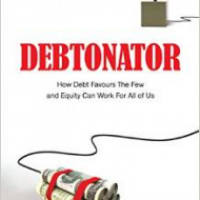
Loading...
20th April 2020

Here we outline some of our thinking on the longer-term implications of the economic shutdown associated with the COVID-19 pandemic.
 The good news is, there is plenty of improving news about the COVID-19 pandemic. Around the world the growth rate of reported infections and fatalities appears to be slowing, the estimates of total fatalities are being revised down substantially, survival rates are very high especially amongst the young and the healthy and are generally being revised upward. To quote the latest update from the University of Oxford’s COVID-19 Evidence Service “The current COVID outbreak seems to be following previous pandemics: initial CFRs (case fatality rates) start high and trend downwards. For example, in Wuhan, the CFR has gone down from 17% in the initial phase to near 1% in the late stage. It is increasingly clear that current testing strategies are not capturing everybody. In South Korea, considerable numbers who tested positive were also asymptomatic likely driving rapid worldwide spread. … Taking account of historical experience, trends in the data, increased number of infections in the population at large, and potential impact of misclassification of deaths, gives a presumed estimate for the COVID-19 Infection Fatality Rate somewhere between 0.1% and 0.36%”
The good news is, there is plenty of improving news about the COVID-19 pandemic. Around the world the growth rate of reported infections and fatalities appears to be slowing, the estimates of total fatalities are being revised down substantially, survival rates are very high especially amongst the young and the healthy and are generally being revised upward. To quote the latest update from the University of Oxford’s COVID-19 Evidence Service “The current COVID outbreak seems to be following previous pandemics: initial CFRs (case fatality rates) start high and trend downwards. For example, in Wuhan, the CFR has gone down from 17% in the initial phase to near 1% in the late stage. It is increasingly clear that current testing strategies are not capturing everybody. In South Korea, considerable numbers who tested positive were also asymptomatic likely driving rapid worldwide spread. … Taking account of historical experience, trends in the data, increased number of infections in the population at large, and potential impact of misclassification of deaths, gives a presumed estimate for the COVID-19 Infection Fatality Rate somewhere between 0.1% and 0.36%”
Some European countries are already lifting aspects of their economic lockdown and others, most notably Sweden, appear to be riding out the pandemic without following a lockdown strategy. We therefore anticipate that, from today April 20th, the economic lockdown will likely be measured in additional weeks rather than months.
If the pandemic is indeed peaking, then doubtless the debate will rage for years to come as to whether closing such large parts of our economies was necessary. Some will argue the worst of the pandemic was avoided only because of the lockdown while others will argue the ultimate scale of the pandemic did not warrant such an economically damaging policy. Within our team we have differing views on this issue, but those views are of no consequence; the shutdown has happened and for now is still ongoing. Our job is to gauge where the economy and therefore financial markets are headed from here.
If we are correct in expecting governments to start lifting the lockdown within the next few weeks, we think the economy will show a rapid V-shaped recovery. We expect the recovery to be driven by an initial rush of deferred spending which ordinarily would have occurred during the lockdown period. In addition, for those with the financial capacity, we also expect a degree of what we call ‘carpe-diem spending’ driven by frustrations of the lockdown. If this occurs, the recovery will likely be robust, and we may see surprising strength in high-end discretionary spending. We note that there have already been reports of a surge in bookings for cruises in 2021, and luxury goods purchases in China are already showing signs of a strong recovery.
Governments and central banks around the world have implemented unprecedented fiscal and monetary stimulus programs to counteract the effect of the shutdown. Concerns about government fiscal deficits and central bank financing of those deficits have been largely forgotten (more on this later). These stimulus programs will be poured into an economy that was, prior to the COVID-19 crisis, in good health. We expect these elevated fiscal deficits will remain in place long after the COVID-19 crisis has faded and, as a rule, fiscal deficits tend to be positive for stock markets. Deficits mean governments are putting more money into the economy through spending than they are taking out of the economy through taxation and much of that excess spending tends to find its way into corporate profits. For this reason, we expect stock markets to quickly recover their losses as the lockdown is eased and thereafter to continue performing well.
In our view, the normalisation of substantial monetised deficit spending will be one of the enduring legacies of the COVID-19 shutdown and, if we are correct, this will have significant implications for investor’s optimal asset allocation in future years. In simple terms, this policy will stimulate strong economic activity at the cost of monetary debasement. Eventually the monetised spending will store up problems, but for now those problems are, we think, too distant and too hypothetical to worry about. In our view, it will be the economies that embrace monetised deficit spending most enthusiastically that will perform best over the coming few years.
We believe, the correct investment response to this environment is to increase allocations to equities – corporate profits will benefit from deficit spending – and decrease allocations to bonds – central banks will continue engineering negative real-yields to support government deficits. As a result, real yields on much of the bond market are likely to remain negative for years to come, amounting to a tax on bond investors. Within the equity markets we expect the biggest deficit spending countries will outperform those using more austere fiscal strategies. In practice this means we expect the US economy and stock market to continue performing well and to continue outperforming Europe, where the fiscal rules of the EU and Eurozone are likely to hamper the economic recovery.
Having said we expect a robust recovery we must temper that enthusiasm in some important respects. Once the pent-up spending boost fades, activity will likely decline to a more normal level. We think this potential secondary, downward adjustment, if it happens, should be seen as a technical correction, but others may interpret it as a stalling or reversal of the recovery. This may result in some further gyrations in the markets.
Sectors involving travel, tourism, entertainment, sport and anything involving large groups of people, have been especially hard hit. Within these sectors there are huge numbers of small businesses – restaurants, pubs, clubs, hotels, theatres, taxi drivers, etc etc – if the UK experience is typical across the board, it is proving difficult for government aid packages to get to these small businesses in a timely manner. At this stage, we simply do not know how quickly this section of the economy will recover. Our suspicion is smaller companies are going to struggle much more than larger ones. This is certainly reflected in the stock markets where small-cap indices have underperformed substantially and are yet to show significant recovery. Many of these companies may never re-open their doors after the lockdown. If so, unemployment, especially amongst those already on the low wages associated with the service sector, may take some time to recover from the crisis.
In the UK, prior to the COVID-19 lockdown, there was much talk about “levelling-up” society but we suspect this will look like a much more distant dream as we come out of lockdown. This is another reason why we anticipate an extended period of monetised deficit spending as governments will face greater ongoing demand from social security programs.
Having already said we expect monetised deficit spending to be normalised by this crisis it is worth emphasising that this was already the direction of travel even prior to the lockdown. Modern Monetary Theory (MMT) promotes the idea that governments should engage in permanent deficit spending and should aim to drive their deficit spending up until the point is reached where the deficit spending begins to cause inflation.
MMT stands in stark conflict with the views of fiscal conservatives who insist governments should run balanced budgets, spending only what they take in as tax receipts. It is also in conflict with the more pragmatic fiscal Keynesians who believe governments should aim to balance their budgets over the economic cycle, having leeway to run deficits in economic downturns and surpluses in boom times.
It is the need to balance budgets over the economic cycle that was used as the rationale for austerity policies following the global financial crisis. So, MMT has become the rallying point for many, especially those on the left, who opposed those austerity policies.
It is far from clear that MMT’s argument for high and permanent monetised deficit spending has won the academic debate. There has not really been much of a debate. But in practice, we think, MMT has already won in policymaking circles. It has won because policy makers are naturally drawn to any theory that gives them a pass to spend without taxing and because, from here, there is no practical alternative to monetised deficit spending.
As pragmatists, we support the monetised deficit spending; it is the only way to avoid turning the COVID-19 slump into a 1930’s style depression. However, we say this with caveats. Governments have chosen to shut down huge sections of their own economies, in response to COVID-19, in a way that has never been attempted before in history. These decisions have been made with very little apparent concern for the associated economic- or even healthcare costs. The epidemic has been modelled but the implications of the shutdown have not. We suspect governments would have been rather more reluctant to take such momentous decisions had they not been operating within an MMT paradigm which told them they could simply print the money to pay for the shutdown. Viewed in this way, it is possible that Modern Monetary Theory will ‘pay the bill’ for the COVID-19 shutdown but it also contributed to swelling the size of the bill in the first place.
The essence of our concern over MMT is that it removes discipline from government spending decisions and that ultimately means, over time, we get less value for money from our government spending. In other words, MMT will eventually debase the value of money sending inflation significantly higher. However, just as a starving person should eat the Big-Mac without concern for its nutritional quality so now is not the time to worry about inflation, the right strategy is to embrace monetised deficit spending and worry about the long-term consequences later.
The movement toward greater monetised deficit spending is the most important of the trends we expect to emerge from the COVID-19 lockdown.
This brings us to our main area of concern over the post-COVID-19 environment.
Europe and especially the eurozone single currency area have long been dogged by lacklustre and divergent economic performance. The northern European economies of Germany, Austria and Netherlands have outperformed the southern economies of Spain and Italy. As a result, the fiscal position of northern Europe is significantly stronger than that of southern Europe. Ordinarily, within a single currency zone, this situation would lead to fiscal transfers between regions but there exist only very limited mechanisms to achieve this within Europe. What’s more, strict limits on government debt levels and deficit spending effectively prohibit the use substantial deficit spending, as endorsed by Modern Monetary Theory. In effect, the rules of the Eurozone have institutionalised an inability to respond effectively to the crisis caused by the COVID-19 shutdown.
The details of the COVID-19 crisis are especially unfortunate for the Eurozone. Within Europe, Italy was the first to suffer a significant outbreak of COVID-19 cases with Spain following close behind. Both these countries implemented extensive economic lockdown programs and both countries are heavily dependent upon travel and tourism. As a result, the economic and fiscal implications for Italy and Spain look to be much greater than for northern European economies. But, because of their already high debt levels and Eurozone rules, they do not have the freedom to support their economies through the crisis.
One of the unknowns is how quickly travel and tourism will return once the lockdown has been eased. As we have already said we expect a rapid V-shaped recovery, but when it comes to foreign travel, tourism and sporting activities there is greater uncertainty. Many of these events require considerable forward planning and as a result we have already witnessed widespread event cancellations going out into the second half of the year. Japan’s Olympic games were due to open July 24th 2020 but will now open July 23rd 2021 – for many sports 2020 could already be entirely lost. Given that we are already in April and we know the lockdowns will persist at least into early May, 2020 could also be a largely lost year for travel and tourism. This would be a substantial economic challenge for Italy and Spain.
How the Eurozone chooses to deal with the divergent prospects of its member countries in the coming weeks will, in our view, be crucial to shaping its economic recovery and even to its prospects of survival in the longer-term. We have long held the view that the Eurozone must eventually either complete its integration or abandon the project altogether and disintegrate. In simple terms we see three paths from here: 1. complete the project, with a pan-eurozone federal budgetary system including taxation, redistribution of tax and debt issuance; 2. unwind the project and return to national currencies with individual budgetary freedoms; 3. fudge the problem, giving Italy and Spain enough fiscal wiggle room to keep them in the union for now, but not enough to either frighten the other members or allow them to achieve real economic recovery.
There has already been calls for Corona bonds issued collectively by Eurozone members to support the economic recovery. However, that plan has already faltered. President Macron of France has stepped up pressure in this regard by making a public appeal for joint debt issuance. But, as things stand, we believe the third ‘fudge’ option remains the most likely path. This we see this as the worst of the three possible options for Europe’s longer-term prospects.
Europe appears to be caught in a catch-22 situation. When things are good there is little pressure to complete the Euro project, when things are bad, for wealthier countries, the cost of completing the project looks too high. If the COVID-19 crisis is not big enough and urgent enough to trigger European fiscal integration, then perhaps nothing ever will. If so, the most likely path is a near term fiscal fudge allowing only a lacklustre recovery in Southern Europe while at the same time putting the Eurozone on a path to eventual disintegration.
Having said we expect a V-shaped recovery generally, with these issues hanging over the Eurozone, we are expecting something looking a bit more like a tilted L-shape in Europe. In many ways what we are describing is a repeat of the events which followed the global financial crisis, which even now, Europe has not fully recovered from.
From an investment perspective the Eurozone fiscal tensions suggest a continuation and perhaps acceleration of existing inter-regional trends. We expect the US and Asian economies to continue outperforming the European economies with that underperformance being reflected in the continued underperformance of European equity markets and the Euro as a currency.
To stretch our nutritional analogy one stage further; Southern Europe is suffering fiscal starvation, badly needing the Big-Mac style calorie boost of monetised deficit spending, but Northern Europe is offering it only the lightest of salads. The Germanic adherence to sound government finances may be theoretically correct, in the long run, but in the short run it looks like the path to failure.
The underperformance of Europe is the second of the important trends we expect the COVID-19 lockdown to extend.
We note, Wolfgang Munchau, who we regard as a considered commentator on European economic issues, has already openly discussed the possibility of an Italian sovereign debt default. Italian government bond yields are beginning to reflect those concerns by widening relative to those of Germany. We will be watching the European sovereign debt markets closely in coming months.
Early in the COVID-19 crisis, Saudi Arabia took the opportunity of falling oil demand to trigger a price war by stepping up its supply of oil. This manoeuvre, we presume, was an attempt to eventually regain pricing power by forcing higher cost producers out of the market.
Whatever the aim, the price war has been spectacularly ‘successful’ in driving oil prices down. Oil prices for early delivery have now fallen below $20 per barrel for the WTI, and even oil prices for delivery at the end of the year remain 40% lower than their pre-crisis levels. We doubt it was intended to push oil prices quite this low. If the futures are to be believed, the oil markets are facing a protracted repricing. It seems to us that the oil price war may have revealed a greater supply-demand imbalance than previously anticipated and in doing so may have inadvertently shifted the market to a new lower price regime. For most of the economy this is very good news, and another reason to anticipate a stronger recovery.
It will be worth paying close attention to the energy market as the post-lockdown environment develops. If oil and energy prices remain subdued there will be a knock-on effect to reduce inflationary pressures. This in turn will lend support to those arguing for greater monetised deficit spending as a defence mechanism against deflationary risks.
Energy price disinflation is the third most important of the trends we expect the COVID-19 lockdown to extend.
There remains some considerable debate about the longer-term implications of the COVID-19 lockdown for inflation broadly. We don’t think it is possible or useful to forecast a simple directional change for inflation. In the near-term demand destruction will almost certainly drive prices lower, while in the long term we feel fiscal deterioration will, as discussed, drive inflation higher. However, even this is likely to prove a gross simplification, we anticipate many divergent price trends as the economy reconfigures itself after COVID-19 with some industries suffering deflation while others experiencing inflation.
Perhaps the easiest of all the trend continuations to forecast is a further rise in the size of the ‘new’ virtual economy relative to the ‘old’ real economy. This is not to say we expect the production of fewer physical goods but rather we expect the spend on activities performed largely over the internet to rise in relative terms.
Some simple changes are obvious. Prior to the lockdown, business continuity planning for many firms involved secondary business sites - large warehouses in the suburbs – with room to replicate existing office accommodation. Social distancing rules rendered this second site model ineffectual. In the future, businesses are going to have to plan for scenarios involving extended periods of dispersed working. This will require more companies to provide employees with portable computers and an acceleration of the migration to storing data in the cloud. Companies will have to plan to replicate their operations virtually and that, we think, means they will reconfigure themselves to operating in that way in normal times also.
In the last few weeks, many of us have become accustomed to holding both internal and external meetings via teleconferencing systems. We suspect this will have helped accelerate a move toward teleconferencing that would have occurred over the next few years anyway. What we are less sure of is whether this will decrease the need for physical business travel or whether it will increase the level of interconnectivity eventually leading to an even higher demand for face to face meetings.
A further rise in contactless cashless payments is also a likely beneficiary of the social distancing measures as ‘contactless’ is now seen as a benefit in its own right.
Prior to the lockdown, the rollout of 5G networks had become mired in the question of which company would supply the infrastructure. That question remains up in the air with perhaps a hardening of the view that national or at least Western champions should control the Western technology infrastructure. Nevertheless, the pressure to provide more cloud storage and greater internet bandwidth is likely to be high in coming years and will put pressure to build the 5G network sooner rather than later. This we see as a positive for technology companies broadly but especially those involved in semiconductor manufacturing, wireless technology, cloud computing and software.
The rise of technology as a proportion of the overall economy is the fourth important trend continuation we expect from the COVID-19 lockdown.
So far, we have only covered existing trends we expect to be extended by the COVID-19 crisis. These are relatively easy to forecast. What is much more difficult to foresee is what might be changed by COVID-19.
National vs Regional vs Global. Many politicians and commentators have proclaimed the COVID-19 lockdown as the turning point in globalisation. The need to manufacture medicines, medical supplies, food and even technology locally, to remove the dependence on interruptible foreign supply chains, has been widely discussed. Anti-globalisation rhetoric was already building prior to the crisis but in aggregate we believe the world trade was still becoming more integrated up until the start of this year. According to data compiled by the World Bank, in 1970 global trade accounted for just 27% of global GDP, by 2008 that had reached an all-time high of 61% where, apart from the post financial crisis year of 2009, it has more or less remained up until now.
Central banks like to claim it was their deft use of interest rate policies which helped control inflation over the last four decades. We suspect a large portion of the credit went to global trade. The globalisation of trade essentially means using labour where its cheapest to produce goods for sale in markets where they are most expensive. This is very good for corporate profits because it sets expensive developed world workers in competition with cheaper emerging market workers, but very bad for Western wages.
Will the shock of the COVID-19 crisis really be enough to derail and reverse the globalisation process? There are a lot of vested interests in keeping the globalisation process on track. That said there is also a growing popular pressure on Western governments to shield their workers and voters from foreign competition. Arguably, both Brexit and President Trump’s Mexican border are symptoms of this anti-globalisation pressure.
At the moment, rhetoric around sourcing medical supplies locally is high, but we do not know if this determination will persist once the emotions fade. We may quickly revert to seeking the cheapest supplier, regardless of their location. But if this rhetoric is part of a growing trend then we may see a rebuilding of manufacturing capacity in the West and with it a recovery of labour pricing power.
It is too early to say if we have witnessed a turning away from globalisation but, if we have, it is likely to help restore the pricing power of Western labour markets and with it bring inflationary pressures back to developed economies. There are certainly many within the central banking community who, worried about a deflationary trap, would welcome such a development.
We expect the global economy to bounce back quickly and convincingly from the economic shutdown. We don’t think the Covid-19 crisis has materially changed the direction of our economies, rather we think it will entrench and accelerate processes that are already happening: greater use of monetised deficit spending; greater strains within and economic underperformance of the Eurozone; structurally cheaper energy prices; a diminishing significance of the old physical economy and rise of new virtual economy; and perhaps, a reversal of globalisation.
 Hedonism and the value of money - Part II
2
Hedonism and the value of money - Part II
2
 Why ownership matters more than ever
2
Why ownership matters more than ever
2
 Can fair fees make active managers more sustainable?
2
Can fair fees make active managers more sustainable?
2
 In Search of Stability & Growth - If only Europe was more like the US
2
In Search of Stability & Growth - If only Europe was more like the US
2
 Interview with our Chief Investment Officer, George Cooper
2
Interview with our Chief Investment Officer, George Cooper
2
 Brochure
1
Brochure
1
 Debtonator - How Equity Can Work for All of US
2
Debtonator - How Equity Can Work for All of US
2
 Depressed lobsters and the dividend yield trap
2
Depressed lobsters and the dividend yield trap
2
 Investment Letter - Eternal Adaptation
2
Investment Letter - Eternal Adaptation
2
 Modern Monetary Theory - The Magic Money Tree
2
Modern Monetary Theory - The Magic Money Tree
2
 Fair Fees
1
Fair Fees
1
 An interview with World Finance
2
An interview with World Finance
2
 Undoing the Mistakes of QE
2
Undoing the Mistakes of QE
2
 The quality focused fund you’ve never heard of
2
The quality focused fund you’ve never heard of
2
 Investment Letter - Constant Reformation
2
Investment Letter - Constant Reformation
2
 Hedonism and the value of money - Part I
2
Hedonism and the value of money - Part I
2
 A creditable recovery
2
A creditable recovery
2
 Crisis Economics
2
Crisis Economics
2
 Captain Kirk and the science of economics
2
Captain Kirk and the science of economics
2
 Facts not Opinions
2
Facts not Opinions
2
 An Impossible Trinity?
2
An Impossible Trinity?
2
 Meerkats and Market Behaviour - Thoughts on October's stock market fall
2
Meerkats and Market Behaviour - Thoughts on October's stock market fall
2
 Debt & the magical mathematics of Brahmagupta
2
Debt & the magical mathematics of Brahmagupta
2
 'Fixing Economics' by George Cooper: Book Review
2
'Fixing Economics' by George Cooper: Book Review
2
 Invest in Resilience
1
Invest in Resilience
1
 Is corporate debt addictive?
2
Is corporate debt addictive?
2
 2016: A Tale of Two Walls
2
2016: A Tale of Two Walls
2
 Build a company on prudence and trust, not debt
2
Register for Updates
12345678
-2
Build a company on prudence and trust, not debt
2
Register for Updates
12345678
-2